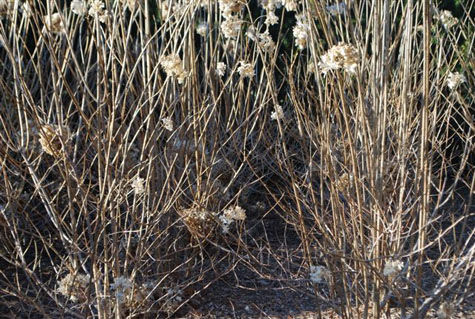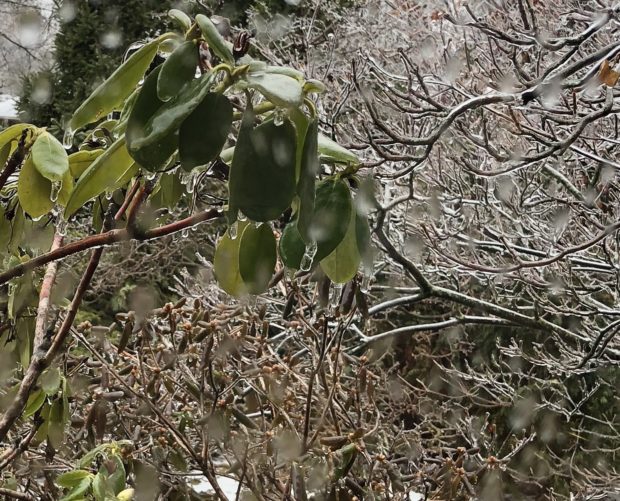 Who can take it-this vile April weather? Mother Nature has been lavish with the bitter cold, snow, wind non-stop since last November. Today, we have significant icing on her cake. Everything outdoors is coated with it. 340,000 people in Michigan have no power. It is even too icy to walk out and take pictures. I am not a good sport about being forced to stare out the window the middle of April. The relentlessness of it all makes me want to fall to the ground and black out. This may sound dramatic, as it should. Winter needs to high tail it out of here.
Who can take it-this vile April weather? Mother Nature has been lavish with the bitter cold, snow, wind non-stop since last November. Today, we have significant icing on her cake. Everything outdoors is coated with it. 340,000 people in Michigan have no power. It is even too icy to walk out and take pictures. I am not a good sport about being forced to stare out the window the middle of April. The relentlessness of it all makes me want to fall to the ground and black out. This may sound dramatic, as it should. Winter needs to high tail it out of here.
 Buck has had enough of my ice storm company today, so he scraped a path from the back door to the steps-just far enough so I could take this picture. He decided a trip to the grocery store through the icy slush was better than watching me wring my hands. We will not be enjoying a spring evening here later. Ha! You would think that after as many springs as I have seen, I could muster a little patience and fortitude. Apparently not. I am a gardener, and I want to get out there. Don’t you?
Buck has had enough of my ice storm company today, so he scraped a path from the back door to the steps-just far enough so I could take this picture. He decided a trip to the grocery store through the icy slush was better than watching me wring my hands. We will not be enjoying a spring evening here later. Ha! You would think that after as many springs as I have seen, I could muster a little patience and fortitude. Apparently not. I am a gardener, and I want to get out there. Don’t you?
 There are many plants in the garden that are not particularly fazed by by leftover winter weather as much as I am. Snow drops are aptly named. From the BBC website, “Their leaves have specially hardened tips to help them break through frozen soil and their sap contains a form of antifreeze to prevent ice crystals forming. On very cold mornings, clumps will flop down as the water is ‘frozen’ inside the cells, but soon perk up again once temperatures rise and the sap can flow again.” Cold weather triggers the transformation of stored starch into sugar in the leaves of the snowdrops. Just like salt on a freezing roadway, the sugar in the water inside snowdrop cells lowers the temperature at which the water in those cells will freeze. Water in plant cells that freezes rock solid destroys those cells. The snowdrop sugary antifreeze helps protect these early harbingers of spring. Snowdrops? They have a DNA that insures the survival of their species. Freezing temperatures rarely bother the early spring bulbs, provided the freeze is of short duration. The DNA of early blooming spring bulbs meeting a delayed Michigan spring-show time.
There are many plants in the garden that are not particularly fazed by by leftover winter weather as much as I am. Snow drops are aptly named. From the BBC website, “Their leaves have specially hardened tips to help them break through frozen soil and their sap contains a form of antifreeze to prevent ice crystals forming. On very cold mornings, clumps will flop down as the water is ‘frozen’ inside the cells, but soon perk up again once temperatures rise and the sap can flow again.” Cold weather triggers the transformation of stored starch into sugar in the leaves of the snowdrops. Just like salt on a freezing roadway, the sugar in the water inside snowdrop cells lowers the temperature at which the water in those cells will freeze. Water in plant cells that freezes rock solid destroys those cells. The snowdrop sugary antifreeze helps protect these early harbingers of spring. Snowdrops? They have a DNA that insures the survival of their species. Freezing temperatures rarely bother the early spring bulbs, provided the freeze is of short duration. The DNA of early blooming spring bulbs meeting a delayed Michigan spring-show time.
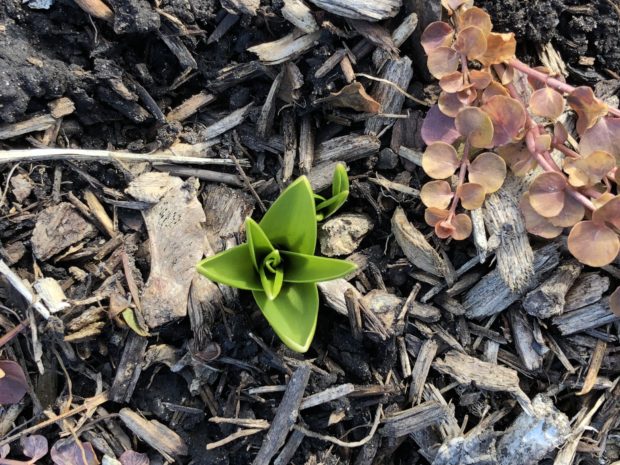 The small spring flowering bulbs have another survival strategy. Many of them thrive in open to medium shade, as the ability to bloom and set seed before the leaves on the trees get to full size means makes for a more successful colony. These spring bulbs are also able to multiply via the production of offsets, which eventually grow into full sized bulbs. As a group, they seem to tolerate tolerate very chilly weather. Once in bloom, their worst enemy is weather that is too warm.
The small spring flowering bulbs have another survival strategy. Many of them thrive in open to medium shade, as the ability to bloom and set seed before the leaves on the trees get to full size means makes for a more successful colony. These spring bulbs are also able to multiply via the production of offsets, which eventually grow into full sized bulbs. As a group, they seem to tolerate tolerate very chilly weather. Once in bloom, their worst enemy is weather that is too warm.
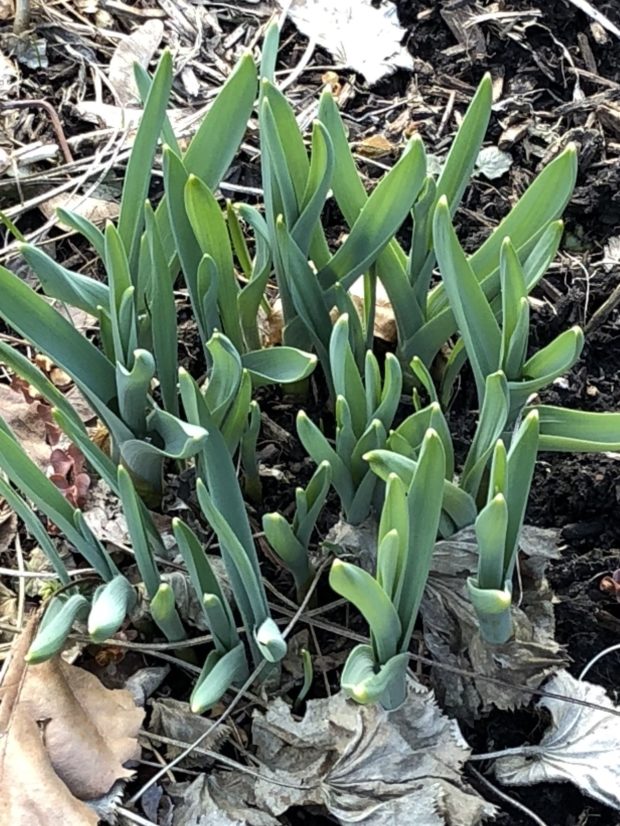 Spring flowering bulbs will send up leaf shoots early, if there is a spell of warm winter weather. If the weather cools back down, their foliage may or may not be damaged by frost. The foliage comes up first. At this stage, the flowers on these daffodils are still safely ensconced below ground. Once the season has shifted to spring, the flower buds will emerge. Once the spring flowering bulbs are in bloom, cool nights are essential to the longevity of the flowers. They will fade fast in hot weather. In love with the idea of a spring garden? Consider spring flowering bulbs, and hope for cool, and not crazy, weather.
Spring flowering bulbs will send up leaf shoots early, if there is a spell of warm winter weather. If the weather cools back down, their foliage may or may not be damaged by frost. The foliage comes up first. At this stage, the flowers on these daffodils are still safely ensconced below ground. Once the season has shifted to spring, the flower buds will emerge. Once the spring flowering bulbs are in bloom, cool nights are essential to the longevity of the flowers. They will fade fast in hot weather. In love with the idea of a spring garden? Consider spring flowering bulbs, and hope for cool, and not crazy, weather.
 Hellebores are incredibly cold tolerant. I have seen flowering stalks laid flat by overnight temperatures in the low 20’s. Once the day warms up, they snap right back as if the insult had never happened. Extraordinary, this. It is fortunate that it is too icy for me to go and take a look at them. I would just be fretting over nothing. This plant shrugs off bad weather. The perennial hellebore is a mainstay of an early spring garden in Michigan. None of my hellebores are in bloom yet. But they will be.
Hellebores are incredibly cold tolerant. I have seen flowering stalks laid flat by overnight temperatures in the low 20’s. Once the day warms up, they snap right back as if the insult had never happened. Extraordinary, this. It is fortunate that it is too icy for me to go and take a look at them. I would just be fretting over nothing. This plant shrugs off bad weather. The perennial hellebore is a mainstay of an early spring garden in Michigan. None of my hellebores are in bloom yet. But they will be.
 My crocus had just come in to full bloom day before yesterday. The flower spikes emerged prior to our last snow. That late season squall did not seem to bother them a bit. The flowers stay closed in cloudy or stormy weather, and and open in sunny weather. This is an adaptation that serves them well. Freezing rain pummeling an open crocus flower would turn it to mush.
My crocus had just come in to full bloom day before yesterday. The flower spikes emerged prior to our last snow. That late season squall did not seem to bother them a bit. The flowers stay closed in cloudy or stormy weather, and and open in sunny weather. This is an adaptation that serves them well. Freezing rain pummeling an open crocus flower would turn it to mush.
 My crocus are quite happy in a bed dominated by Baltic ivy. I never notice their foliage ripening. Crocus are beautiful grown in grass, but my grass is not fit for company this time of year. I like them much better in groundcover, or a perennial bed.
My crocus are quite happy in a bed dominated by Baltic ivy. I never notice their foliage ripening. Crocus are beautiful grown in grass, but my grass is not fit for company this time of year. I like them much better in groundcover, or a perennial bed.
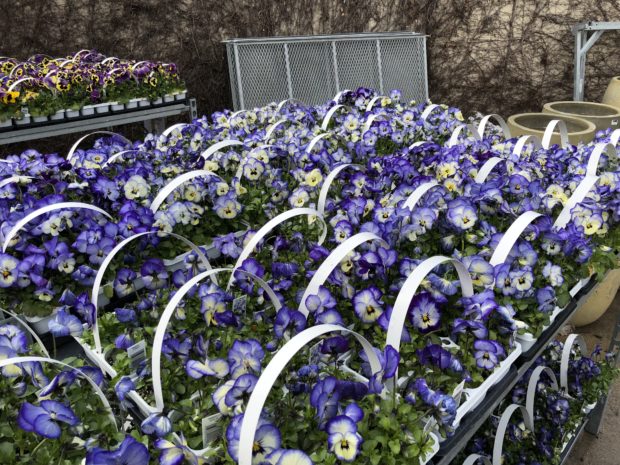 Pansies and violas are quite cold tolerant, provided they have had a chance to harden off with measured exposure to cold weather. All of ours are cold grown the previous fall, and wintered over in a greenhouse without heat. They are ready to go in the garden immediately. Like other spring blooming plants, they can tolerate very cold temperatures as long as those super cold temperatures don’t last too long. I have seen them bounce back from a 19 degree night. What they do not like is wind. It makes sense that these big flat faced flowers would not fare well in a gale.
Pansies and violas are quite cold tolerant, provided they have had a chance to harden off with measured exposure to cold weather. All of ours are cold grown the previous fall, and wintered over in a greenhouse without heat. They are ready to go in the garden immediately. Like other spring blooming plants, they can tolerate very cold temperatures as long as those super cold temperatures don’t last too long. I have seen them bounce back from a 19 degree night. What they do not like is wind. It makes sense that these big flat faced flowers would not fare well in a gale.
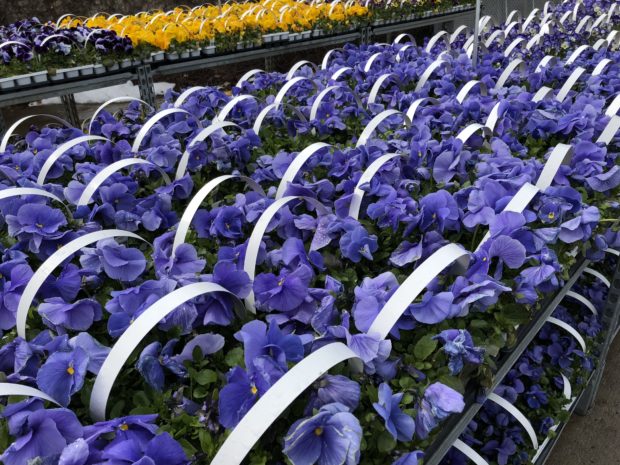 Detroit Garden Works is putting up a 30 foot wide by 60 foot long high gothic tunnel house this coming week. Hooray. At long last we won’t have to haul tender plants in and out of the garage. We have been covering our pansies at night for several weeks, with a double thickness of row cover, or frost cloth. This very lightweight non woven fabric can keep the temperature underneath 5 to 8 degrees warmer than the air temperature. 5to 8 degrees can be a game changer. We zip tie bamboo stakes to our plant tables, stretch the cloth tight, and rubber band it to the tops of the stakes. We further zip tie the fabric at the bottom to the bottom rail of the table. That fabric can damage plants if it is able to inflate and deflate on a windy night. Every table looks like a neatly made bed. I am over making beds. I favor a house under which we can grow and sustain great plants. Our tunnel house will be the perfect thing to protect our plants from all sorts of bad weather. A shade cloth over it will help to maintain a proper moisture level in the heat of the summer. Our grower Karen is happy about the house. Me too.
Detroit Garden Works is putting up a 30 foot wide by 60 foot long high gothic tunnel house this coming week. Hooray. At long last we won’t have to haul tender plants in and out of the garage. We have been covering our pansies at night for several weeks, with a double thickness of row cover, or frost cloth. This very lightweight non woven fabric can keep the temperature underneath 5 to 8 degrees warmer than the air temperature. 5to 8 degrees can be a game changer. We zip tie bamboo stakes to our plant tables, stretch the cloth tight, and rubber band it to the tops of the stakes. We further zip tie the fabric at the bottom to the bottom rail of the table. That fabric can damage plants if it is able to inflate and deflate on a windy night. Every table looks like a neatly made bed. I am over making beds. I favor a house under which we can grow and sustain great plants. Our tunnel house will be the perfect thing to protect our plants from all sorts of bad weather. A shade cloth over it will help to maintain a proper moisture level in the heat of the summer. Our grower Karen is happy about the house. Me too.
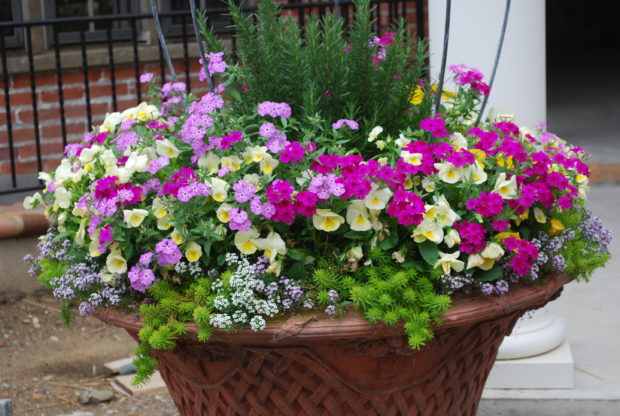 But sooner or later the weather will turn to spring. I am hoping it will be a long and temperate season. I cannot wait for all of the early season plants to arrive. The annual phlox, violas, angelina, and alyssum surround a rosemary in this spring container planting makes me long for better weather.
But sooner or later the weather will turn to spring. I am hoping it will be a long and temperate season. I cannot wait for all of the early season plants to arrive. The annual phlox, violas, angelina, and alyssum surround a rosemary in this spring container planting makes me long for better weather.
 This picture of a trio of spring containers was taken a few years ago on May 31. Think of it. If spring lasts until the first of June, we have a lot of springtime ahead of us.
This picture of a trio of spring containers was taken a few years ago on May 31. Think of it. If spring lasts until the first of June, we have a lot of springtime ahead of us.
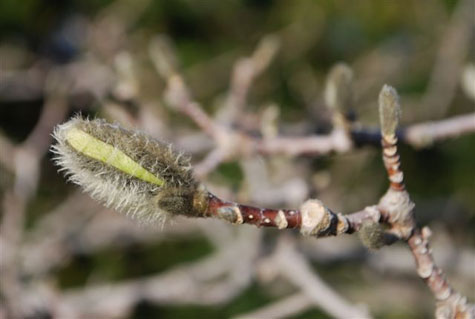 Only a gardener, obsessed for the first sign of spring, would in their next breath complain about inordinately warm temperatures! 71 degrees in Michigan, March 17, is too very warm. Daffodils and crocus shoot up as though shocked by a bolt of electricity. An unknown dwarf magnolia in my yard has every fuzzy hair on every bud, standing at attention. This makes me cringe-I am well aware that Michigan has snow and very cold temperatures well into April. Devastating-the sight of frost-browned spring flowers.
Only a gardener, obsessed for the first sign of spring, would in their next breath complain about inordinately warm temperatures! 71 degrees in Michigan, March 17, is too very warm. Daffodils and crocus shoot up as though shocked by a bolt of electricity. An unknown dwarf magnolia in my yard has every fuzzy hair on every bud, standing at attention. This makes me cringe-I am well aware that Michigan has snow and very cold temperatures well into April. Devastating-the sight of frost-browned spring flowers.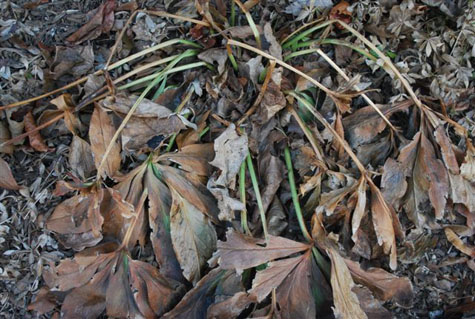 March, and into April, is the worst part of our gardening year. Meaning, this time of year features the best of the worst that can be. You can spend a weekend raking, and in four days there is no trace you were ever there. Brown is still the dominant feature. Unless you have designed your landscape to bridge the seasons, all that brown can beat you down.
March, and into April, is the worst part of our gardening year. Meaning, this time of year features the best of the worst that can be. You can spend a weekend raking, and in four days there is no trace you were ever there. Brown is still the dominant feature. Unless you have designed your landscape to bridge the seasons, all that brown can beat you down.